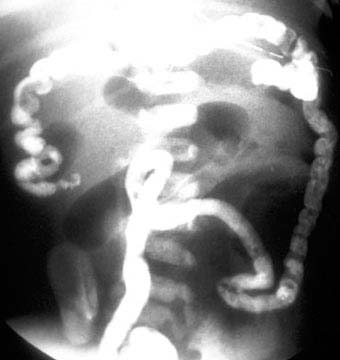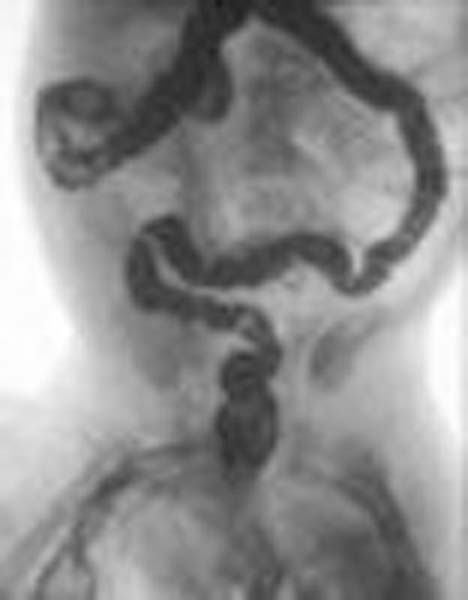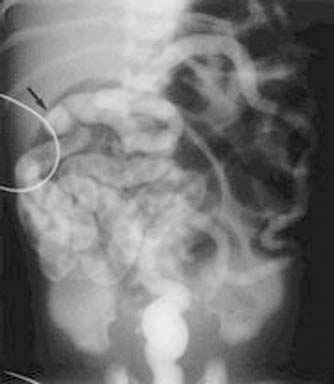Meconium ileus: Difference between revisions
Ahmed Younes (talk | contribs) |
|||
| Line 39: | Line 39: | ||
</gallery> | </gallery> | ||
Meconium ileus must be differentiated from other diseases that cause a failure to pass [[meconium]] or [[abdominal distension]] in infants, including [[meconium plug syndrome]], [[small left colon syndrome]], and [[congenital hypothyroidism]]. | |||
{| class="wikitable" | |||
!Disease | |||
!Prominent clinical features | |||
!Radiological findings | |||
|- | |||
|[[Meconium plug syndrome]] | |||
| | |||
* Transient [[intestinal obstruction]] for 1-2 days after birth. | |||
* Obstruction is functional due to dilated colon and delayed passage of feces. | |||
* Usually seen in [[premature infants]].<ref name="pmid18485962">{{cite journal |vauthors=Keckler SJ, St Peter SD, Spilde TL, Tsao K, Ostlie DJ, Holcomb GW, Snyder CL |title=Current significance of meconium plug syndrome |journal=J. Pediatr. Surg. |volume=43 |issue=5 |pages=896–8 |year=2008 |pmid=18485962 |pmc=3086204 |doi=10.1016/j.jpedsurg.2007.12.035 |url=}}</ref> | |||
|[[Image:Meconium-plug-syndrome - Case courtesy of Radswiki, Radiopaedia.org, rID 11606.jpg|center|300px|thumb|Abdominal x-ray with contrast showing inspissated meconium in the intestine, proximal to the colon - Case courtesy of Radswiki, Radiopaedia.org, rID 11606]] | |||
|- | |||
|[[Small left colon syndrome]] | |||
| | |||
* Reduced caliber of the [[colon]] starting from [[splenic flexure]] and going down, causing [[intestinal obstruction]]. | |||
* Characterized by a sudden change of the colon diameter. | |||
* Usually associated with [[gestational diabetes]].<ref name="pmid910057">{{cite journal |vauthors=Berdon WE, Slovis TL, Campbell JB, Baker DH, Haller JO |title=Neonatal small left colon syndrome: its relationship with aganglionosis and meconium plug syndrome |journal=Radiology |volume=125 |issue=2 |pages=457–62 |year=1977 |pmid=910057 |doi=10.1148/125.2.457 |url=}}</ref> | |||
|[[Image:Small-left-colon-syndrome-1 - Case courtesy of Dr Eric F Greif, Radiopaedia.org, rID 30024.jpg|center|300px|thumb|Abdominal x-ray with contrast, shows decreased caliber of the descending and sigmoid colon, loss of haustration along with filling defects corresponding to retained feces - Case courtesy of Dr Eric F Greif, Radiopaedia.org, rID 30024]] | |||
|- | |||
|[[Intestinal atresia|Distal small intestine/colon atresia]] | |||
| | |||
* Failure to pass [[meconium]] due to failure of intestine recanalization. | |||
* Proximal [[lesions]] have an earlier onset of symptoms than distal [[lesions]]. | |||
* [[Intestinal atresia|Colonic atresia]] may affect normal children or may be associated with other abnormalities as Hirschsprung's disease or [[gastroschisis]].<ref name="pmid17077911">{{cite journal |vauthors=Spitz L |title=Observations on the origin of congenital intestinal atresia |journal=S. Afr. Med. J. |volume=96 |issue=9 Pt 2 |pages=864 |year=2006 |pmid=17077911 |doi= |url=}}</ref> | |||
|[[Image:Small-bowel-atresia - Case courtesy of A.Prof Frank Gaillard, Radiopaedia.org, rID 5959.jpg|center|300px|thumb|Normal appearing colon that is small and unused. Contrast fills the whole colon and passes to the ileum - Case courtesy of A.Prof Frank Gaillard, Radiopaedia.org, rID 5959]] | |||
|- | |||
|[[Meconium ileus]] | |||
| | |||
* [[Intestinal obstruction]] due to inspissation of [[meconium]] in the [[Ileum|distal ileum]]. | |||
* Most cases of [[meconium ileus]] are secondary to [[cystic fibrosis]]. | |||
* Typically presents with failure to pass [[meconium]] and [[abdominal distension]] with or without [[vomiting]]. | |||
* [[Meconium ileus]] may first present with complications, including [[perforation]] and [[volvulus]].<ref name="pmid14237408">{{cite journal |vauthors=HOLSCLAW DS, ECKSTEIN HB, NIXON HH |title=MECONIUM ILEUS. A 20-YEAR REVIEW OF 109 CASES |journal=Am. J. Dis. Child. |volume=109 |issue= |pages=101–13 |year=1965 |pmid=14237408 |doi= |url=}}</ref> | |||
|[[Image:Meconium-ileus-neonate-with-cystic-fibrosis - Case courtesy of Dr Michael Sargent, Radiopaedia.org, rID 6009.jpg|center|300px|thumb|Contrast enema shows inspissated meconium starting from the mid-sigmoid colon and going up till the splenic flexure. The colon is normal in diameter, ruling out microcolon - Case courtesy of Dr Michael Sargent, Radiopaedia.org, rID 6009]] | |||
|- | |||
|[[Congenital hypothyroidism]] | |||
| | |||
*Most infants are born [[asymptomatic]].<ref name="pmid2295961">{{cite journal |vauthors= |title=Elementary school performance of children with congenital hypothyroidism. New England Congenital Hypothyroidism Collaborative |journal=J. Pediatr. |volume=116 |issue=1 |pages=27–32 |year=1990 |pmid=2295961 |doi= |url=}}</ref> | |||
*Symptoms, if present, may include, but not limited to: | |||
**[[Macroglossia]] | |||
**Hoarse cry | |||
**[[Umbilical hernia]] | |||
**Puffy facies | |||
**Increased head circumference | |||
**[[Hypothermia]] | |||
| | |||
|} | |||
==Related Chapters== | ==Related Chapters== | ||
*[[Meconium]] | *[[Meconium]] | ||
*[[Meconium plug syndrome]] | *[[Meconium plug syndrome]] | ||
==References== | ==References== | ||
{{reflist|2}} | {{reflist|2}} | ||
Latest revision as of 16:16, 29 August 2017
|
WikiDoc Resources for Meconium ileus |
|
Articles |
|---|
|
Most recent articles on Meconium ileus Most cited articles on Meconium ileus |
|
Media |
|
Powerpoint slides on Meconium ileus |
|
Evidence Based Medicine |
|
Clinical Trials |
|
Ongoing Trials on Meconium ileus at Clinical Trials.gov Trial results on Meconium ileus Clinical Trials on Meconium ileus at Google
|
|
Guidelines / Policies / Govt |
|
US National Guidelines Clearinghouse on Meconium ileus NICE Guidance on Meconium ileus
|
|
Books |
|
News |
|
Commentary |
|
Definitions |
|
Patient Resources / Community |
|
Patient resources on Meconium ileus Discussion groups on Meconium ileus Patient Handouts on Meconium ileus Directions to Hospitals Treating Meconium ileus Risk calculators and risk factors for Meconium ileus
|
|
Healthcare Provider Resources |
|
Causes & Risk Factors for Meconium ileus |
|
Continuing Medical Education (CME) |
|
International |
|
|
|
Business |
|
Experimental / Informatics |
Editor-In-Chief: C. Michael Gibson, M.S., M.D. [1]
Overview
Meconium found in the intestine of a newborn, consisting of succus entericus (bile salts, bile acids, and debris from the intestinal mucosa) Meconium is normally evacuated within 6 hours of birth or earlier. Meconium ileus occurs with meconium becomes inspissated and obstructs the distal ileum. It is usually a manifestation of cystic fibrosis. It is usually understood as synonymous with cystic fibrosis until proven otherwise. Approximately 20% of infants with cystic fibrosis present with meconium ileus at birth. It may also be seen with pancreatic atresia or stenosis of the pancreatic duct. It may rarely occur without cystic fibrosis or pancreatic abnormality in cases likely related to gut immaturity (more favorable outcome). Further complications include ileal atresia or stenosis, ileal perforation, meconium peritonitis, and volvulus with or without pseudocyst formation. It is more common in white populations. It affects both sexes almost equally.
Imaging Findings
- Prenatal ultrasound findings associated with meconium ileus include polyhydramnios, fetal ascites, peritoneal wall calcifications, and intraabdominal cysts.
- Meconium is normally invisible radiographically.
- Occassionally, has a mottled appearance on radiographs during the first 2 days of life.
- Classically, a paucity or absence of air-fluid levels and a "bubbly" appearance of distended intestinal loops on radiographs.
- Microcolon seen on barium enema.
- Characteristic findings often not seen, and thus relatively unreliable.
Patient #1
Patient #2
Patient #3
Meconium ileus must be differentiated from other diseases that cause a failure to pass meconium or abdominal distension in infants, including meconium plug syndrome, small left colon syndrome, and congenital hypothyroidism.
| Disease | Prominent clinical features | Radiological findings |
|---|---|---|
| Meconium plug syndrome |
|
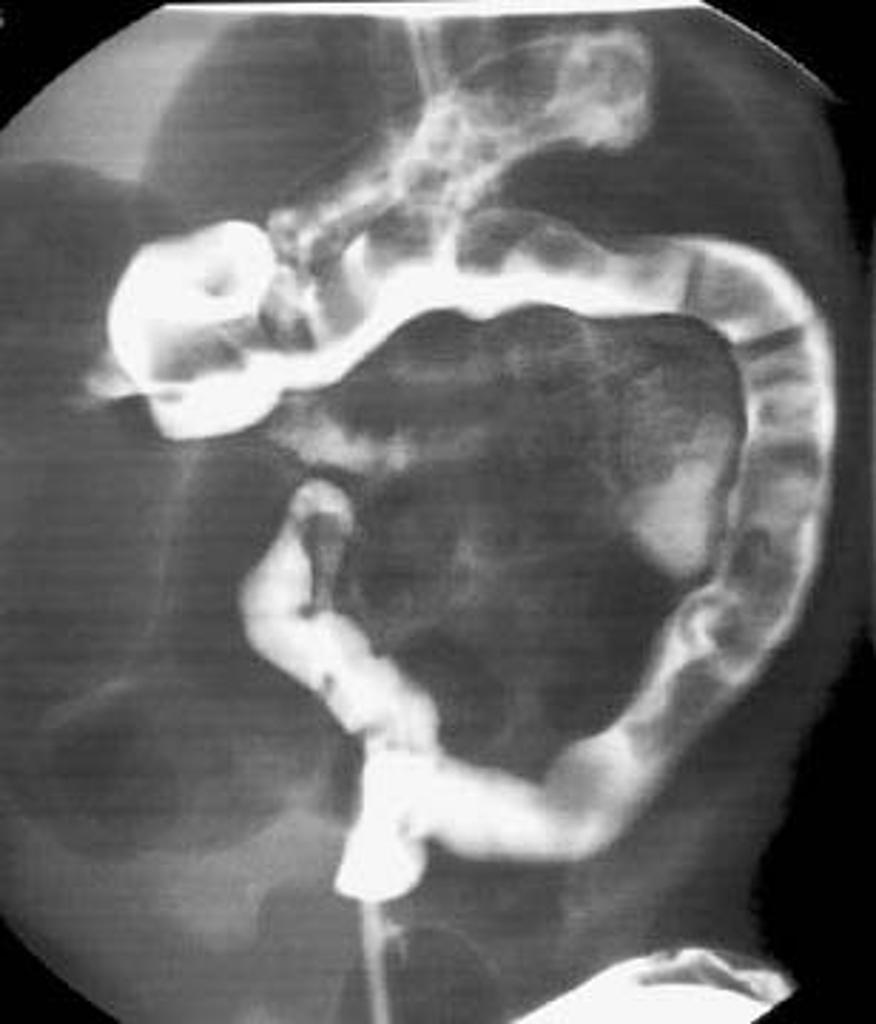 |
| Small left colon syndrome |
|
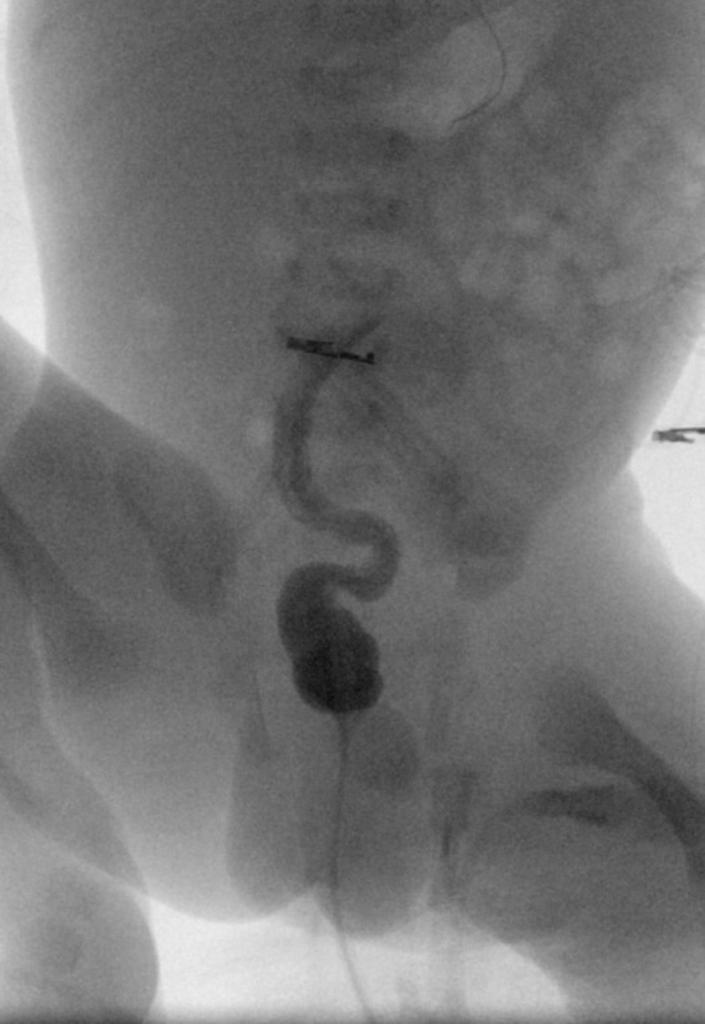 |
| Distal small intestine/colon atresia |
|
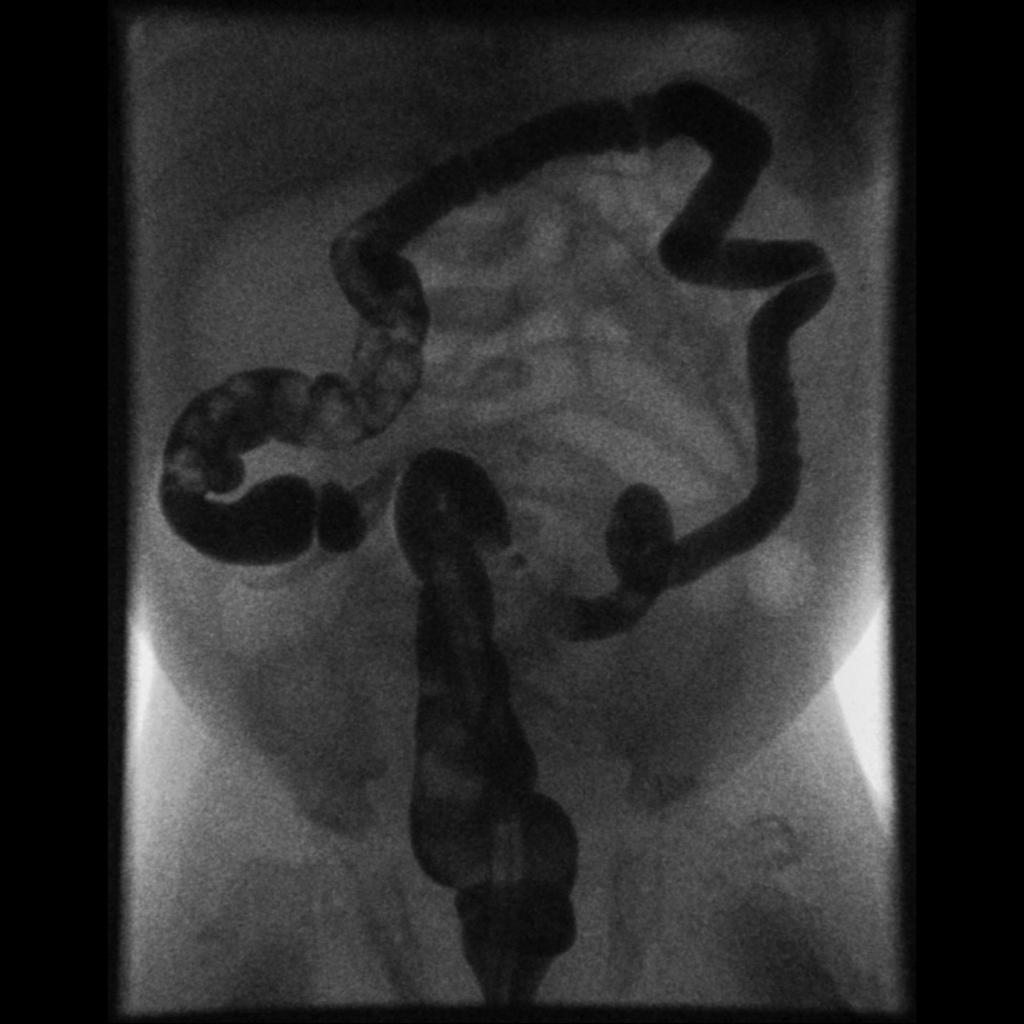 |
| Meconium ileus |
|
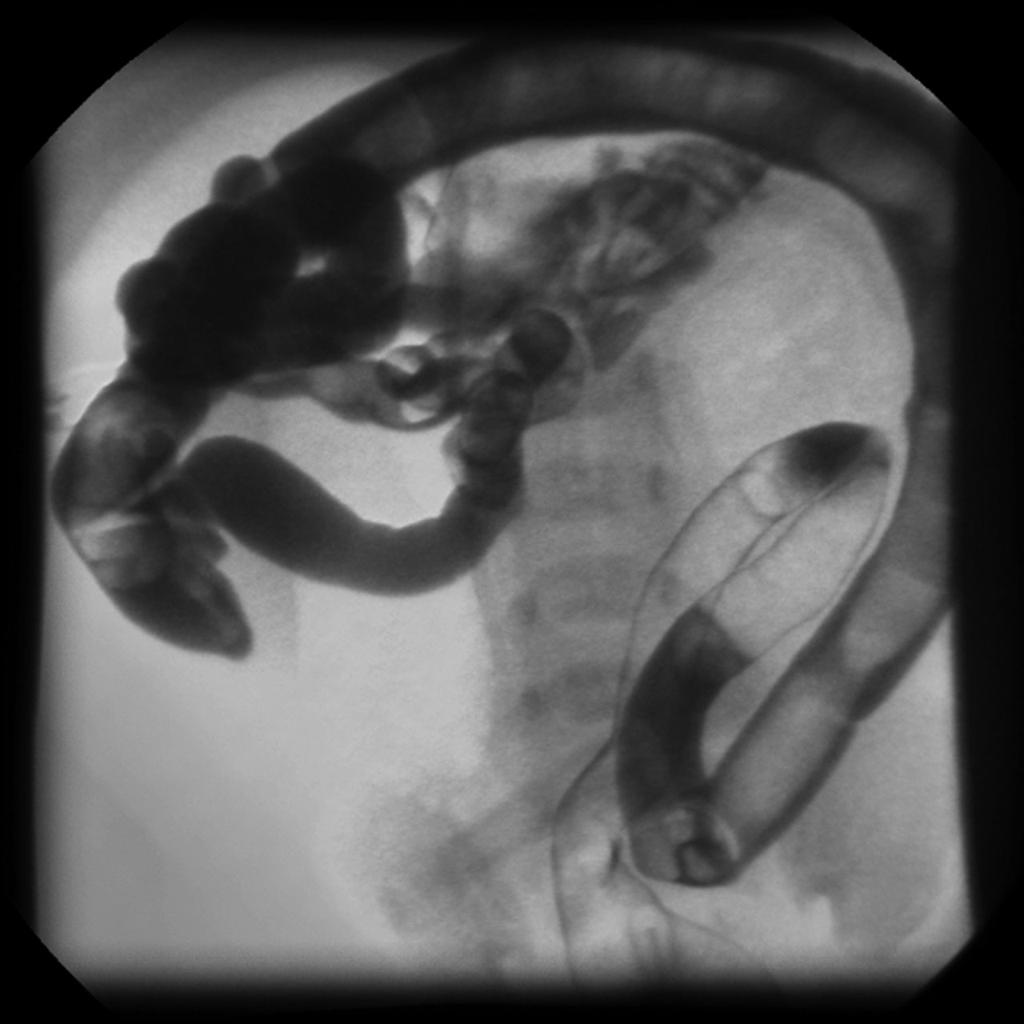 |
| Congenital hypothyroidism |
|
Related Chapters
References
- ↑ Keckler SJ, St Peter SD, Spilde TL, Tsao K, Ostlie DJ, Holcomb GW, Snyder CL (2008). "Current significance of meconium plug syndrome". J. Pediatr. Surg. 43 (5): 896–8. doi:10.1016/j.jpedsurg.2007.12.035. PMC 3086204. PMID 18485962.
- ↑ Berdon WE, Slovis TL, Campbell JB, Baker DH, Haller JO (1977). "Neonatal small left colon syndrome: its relationship with aganglionosis and meconium plug syndrome". Radiology. 125 (2): 457–62. doi:10.1148/125.2.457. PMID 910057.
- ↑ Spitz L (2006). "Observations on the origin of congenital intestinal atresia". S. Afr. Med. J. 96 (9 Pt 2): 864. PMID 17077911.
- ↑ HOLSCLAW DS, ECKSTEIN HB, NIXON HH (1965). "MECONIUM ILEUS. A 20-YEAR REVIEW OF 109 CASES". Am. J. Dis. Child. 109: 101–13. PMID 14237408.
- ↑ "Elementary school performance of children with congenital hypothyroidism. New England Congenital Hypothyroidism Collaborative". J. Pediatr. 116 (1): 27–32. 1990. PMID 2295961.
